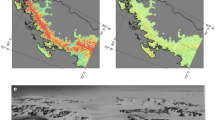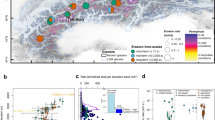Abstract
Theoretical analysis predicts that enhanced erosion related to late Cenozoic global cooling can act as a first-order influence on the internal dynamics of mountain building, leading to a reduction in orogen width and height1,2,3. The strongest response is predicted in orogens dominated by highly efficient alpine glacial erosion, producing a characteristic pattern of enhanced erosion on the windward flank of the orogen and maximum elevation controlled by glacier equilibrium line altitude3,4, where long-term glacier mass gain equals mass loss. However, acquiring definitive field evidence of an active tectonic response to global climate cooling has been elusive5. Here we present an extensive new low-temperature thermochronologic data set from the Patagonian Andes, a high-latitude active orogen with a well-documented late Cenozoic tectonic, climatic and glacial history. Data from 38° S to 49° S record a marked acceleration in erosion 7 to 5 Myr ago coeval with the onset of major Patagonian glaciation6 and retreat of deformation from the easternmost thrust front7. The highest rates and magnitudes of erosion are restricted to the glacial equilibrium line altitude on the windward western flank of the orogen, as predicted in models of glaciated critical taper orogens where erosion rate is a function of ice sliding velocity3,8. In contrast, towards higher latitudes (49° S to 56° S) a transition to older bedrock cooling ages signifies much reduced late Cenozoic erosion despite dominantly glacial conditions here since the latest Miocene6. The increased height of the orogenic divide at these latitudes (well above the equilibrium line altitude) leads us to conclude that the southernmost Patagonian Andes represent the first recognized example of regional glacial protection of an active orogen from erosion, leading to constructive growth in orogen height and width.
This is a preview of subscription content, access via your institution
Access options
Subscribe to this journal
Receive 51 print issues and online access
$199.00 per year
only $3.90 per issue
Buy this article
- Purchase on Springer Link
- Instant access to full article PDF
Prices may be subject to local taxes which are calculated during checkout




Similar content being viewed by others
References
Whipple, K. X. & Meade, B. J. Orogen response to changes in climatic and tectonic forcing. Earth Planet. Sci. Lett. 243, 218–228 (2006)
Stolar, D., Roe, G. & Willett, S. Controls on the patterns of topography and erosion rate in a critical orogen. J. Geophys. Res. 112 F04002 10.1029/2006JF000713 (2007)
Tomkin, J. H. & Roe, G. H. Climate and tectonic controls on glaciated critical-taper orogens. Earth Planet. Sci. Lett. 262, 385–397 (2007)
Berger, A. L. et al. Quaternary tectonic response to intensified glacial erosion in an orogenic wedge. Nature Geosci. 1, 793–799 (2008)
Whipple, K. X. The influence of climate on the tectonic evolution of mountain belts. Nature Geosci. 2, 97–104 (2009)
Mercer, J. H. & Sutter, J. F. Late Miocene earliest Pliocene glaciation in southern Argentina—implications for global icesheet history. Palaeogeogr. Palaeoclimatol. Palaeoecol. 38, 185–206 (1982)
Ramos, V. A. Seismic ridge subduction and topography: foreland deformation in the Patagonian Andes. Tectonophysics 399, 73–86 (2005)
Tomkin, J. H. Coupling glacial erosion and tectonics at active orogens: a numerical modeling study. J. Geophys. Res. 112 F02015 10.1029/2005JF000332 (2007)
Porter, S. C. Pleistocene glaciation in the southern Lake District of Chile. Quat. Res. 16, 263–292 (1981)
Montgomery, D. R., Balco, G. & Willett, S. D. Climate, tectonics, and the morphology of the Andes. Geology 29, 579–582 (2001)
Egholm, D. L., Nielsen, S. B., Pedersen, V. K. & Leseman, J.-E. Glacial effects limiting mountain height. Nature 460, 884–888 (2009)
Thomson, S. N. Late Cenozoic geomorphic and tectonic evolution of the Patagonian Andes between latitudes 42°S and 46°S: an appraisal based on fission-track results from the transpressional intra-arc Liquine-Ofqui fault zone. Geol. Soc. Am. Bull. 114, 1159–1173 (2002)
Brozovic, N., Burbank, D. W. & Meigs, A. J. Climatic limits on landscape development in the northwestern Himalaya. Science 276, 571–574 (1997)
Broecker, W. S. & Denton, G. H. The role of ocean-atmosphere reorganizations in glacial cycles. Quat. Sci. Rev. 9, 305–341 (1990)
Willett, S. D. Orogeny and orography: the effects of erosion on the structure of mountain belts. J. Geophys. Res. 104, 28957–28981 (1999)
Molnar, P. & England, P. Late Cenozoic uplift of mountain ranges and global climate change—chicken or egg? Nature 346, 29–34 (1990)
Fitzgerald, P. G., Sorkhabi, R. B., Redfield, T. F. & Stump, E. Uplift and denudation of the central Alaska Range: a case study in the use of apatite fission track thermochronology to determine absolute uplift parameters. J. Geophys. Res. 100, 20175–20191 (1995)
Blisniuk, P. M., Stern, L. A., Chamberlain, C. P., Idleman, B. & Zeitler, P. K. Climatic and ecologic changes during Miocene surface uplift in the southern Patagonian Andes. Earth Planet. Sci. Lett. 230, 125–142 (2005)
Reiners, P. W., Ehlers, T. A., Mitchell, S. G. & Montgomery, D. R. Coupled spatial variations in precipitation and long-term erosion rates across the Washington Cascades. Nature 426, 645–647 (2003)
DaSilva, J. L., Anderson, J. B. & Stravers, J. Seismic facies changes along a nearly continuous 24 degrees latitudinal transect: the fjords of Chile and the northern Antarctic peninsula. Mar. Geol. 143, 103–123 (1997)
Hervé, F., Pankhurst, R. J., Fanning, C. M., Calderón, M. & Yaxley, G. M. The South Patagonian batholith: 150 my of granite magmatism on a plate margin. Lithos 97, 373–394 (2007)
Flynn, J. J. et al. A new fossil mammal assemblage from the southern Chilean Andes: implications for geology, geochronology, and tectonics. J. S. Am. Earth Sci. 15, 285–302 (2002)
Coutand, I. et al. Structure and kinematics of a foothills transect, Lago Viedma, southern Andes (49 degrees 30' S). J. S. Am. Earth Sci. 12, 1–15 (1999)
Fosdick, J. C. Late Miocene exhumation of the Magallanes Basin and sub-Andean fold belt, southern Chile: new constraints from apatite U-Th/He thermochronology. GSA Abstr. 39, 341 (2007)
Harambour, S. M. Deep-seated thrusts in the frontal part of the Magallanes fold and thrust belt, Ultima Esperanza, Chile. 15th Congr. Geol. Argentino Actas 3, 232 (2002)
Hulton, N. R. J., Purves, R. S., McCulloch, R. D., Sugden, D. E. & Bentley, M. J. The Last Glacial Maximum and deglaciation in southern South America. Quat. Sci. Rev. 21, 233–241 (2002)
Swift, D. A., Persano, C., Stuart, F. M., Gallagher, K. & Whitham, A. A reassessment of the role of ice sheet glaciation in the long-term evolution of the East Greenland fjord region. Geomorphology 97, 109–125 (2008)
Sugden, D. E. Glacial erosion by the Laurentide ice sheet. J. Glaciol. 20, 367–391 (1978)
Fabel, D. et al. Landscape preservation under Fennoscandian ice sheets determined from in situ produced Be-10 and Al-26. Earth Planet. Sci. Lett. 201, 397–406 (2002)
Reiners, P. W. & Brandon, M. T. Using thermochronology to understand orogenic erosion. Annu. Rev. Earth Planet. Sci. 34, 19–66 (2006)
Acknowledgements
This work was supported by the NSF Geomorphology and Land Use Dynamics and Tectonics Award EAR0447140. S. Nicolescu assisted with (U–Th)/He analysis. S.N.T. thanks F. Hervé for numerous invitations to take part in boat expeditions in the Chilean fjords made possible through Chilean Fondecyt awards 1010412, 1050431, 7010412 and 7060240. Captains C. Alvarez Senior and Junior, V. Alvarez, D. Lleufo and C. Porter expertly guided us through the Chilean fjords on the boats Mama Dina, Penguin, Foam, 21 de Mayo and R/V Gondwana. We thank R. Fuenzalida and C. Mpodozis at ENAP/Sipetrol for allowing us to publish the apatite fission track data from the SP samples. H. Echtler and J. Glodny at the GFZ Potsdam, and F. Hervé at the Universidad de Chile provided additional apatite sample separates. This work benefited from discussions with G. Roe and M. Kaplan.
Author information
Authors and Affiliations
Contributions
Writing and interpretation was done by S.N.T. with contributions from M.T.B., J.H.T. and P.W.R. Fieldwork was performed by S.N.T., M.T.B., J.H.T., P.W.R. and C.V. Apatite fission track analysis was done by S.N.T. (U–Th)/He dating was carried out by S.N.T., N.J.W. and C.V.
Corresponding author
Ethics declarations
Competing interests
The authors declare no competing financial interests.
Supplementary information
Supplementary Information
This file contains Supplementary Notes 1-3, additional references and Supplementary Tables 1-3. (PDF 946 kb)
Rights and permissions
About this article
Cite this article
Thomson, S., Brandon, M., Tomkin, J. et al. Glaciation as a destructive and constructive control on mountain building. Nature 467, 313–317 (2010). https://doi.org/10.1038/nature09365
Received:
Accepted:
Issue Date:
DOI: https://doi.org/10.1038/nature09365
This article is cited by
-
Medieval demise of a Himalayan giant summit induced by mega-landslide
Nature (2023)
-
Ice flux of alpine glaciers controls erosion and landscape in the Nianbaoyeze Shan, northeastern Tibetan Plateau
Journal of Mountain Science (2023)
-
Climatic control on the location of continental volcanic arcs
Scientific Reports (2022)
-
Large landslides cluster at the margin of a deglaciated mountain belt
Scientific Reports (2022)
-
A report on tectonically sculptured unique glacier landform: a case study from the Tethys Kumaun Himalaya, India
Geosciences Journal (2022)
Comments
By submitting a comment you agree to abide by our Terms and Community Guidelines. If you find something abusive or that does not comply with our terms or guidelines please flag it as inappropriate.



